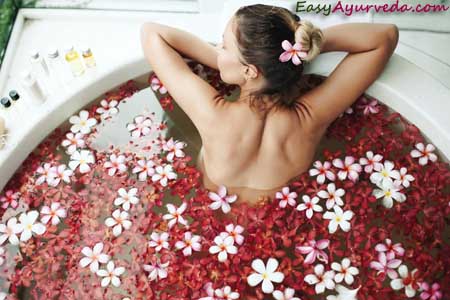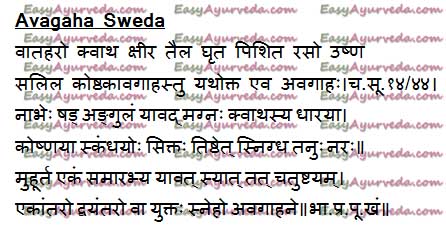Avagaha Sweda – Tub Bath Sudation, Meaning, Method of doing, Health Benefits
Article by Dr Raghuram Y.S. MD (Ay) & Dr Manasa, B.A.M.S
Avagaha means dipping, immerse,
Swedana means sudation, steaming, sweating,
Avagaha Sweda is a type of sudation in which the patient who has been given Abhyanga (herbal oil massage) is made to lie down to the neck level in a tub big enough to accommodate a person, filled with medicinal decoctions and other liquids.
Table of Contents
Category
Avagaha is one among the 13 types of Saagni Sweda (Sa=with, Agni=fire). In this swedana type since hot fluids are used, which have been processed with medicines only after contact with heat or fire (through heating or boiling on fire), it is categorized under Saagni Sweda.
Since warm fluids are used in this treatment it is also a type of Drava Sweda (sudation done through warm fluids) or Ardra Sweda (wet sudation procedure).
Avagaha Sweda
The person (patient) who is to be given Avagaha Sweda is given Abhyanga (herbal oil massage) with Vatahara tailas (oils which alleviate vitiated vata). He is later made to sit in a big tub having the dimensions enough to accommodate him. He should sit in the tub such that his neck and head are out of the tub. The tub should be filled with hot vatahara dravas (liquids having vata alleviating property). These liquids may be one or the other among –
- Vatahara Patra Kwatha – decoctions made by processing leaves having vata-alleviating property in water
- Vatahara Kwatha Siddha Ksheera – milk processed with the vata alleviating decoctions
- Taila – medicated oils
- Ghrita – medicated ghee
- Mamsarasa – meat soup
- Ushnodaka –warm water etc

Sudation provided by making the person sit in the tub filled with one or the other of the warm liquids as mentioned above is called Avagaha Sweda.
Materials required
Materials needed for Avagaha Sweda
Avagaha Droni or the Avagaha tub (bath tub) –
Avagaha Tub is a mandatory need for this treatment.
Dimensions of the Avagaha Tub – The tub should be big enough to comfortably accommodate the entire length and breadth of a person. The tub should be 6 feet (approximately) in length, approximately 2 feet in width and 1.5 feet in height. The tub should have an opening at one of its corners for draining the liquid after the treatment. It should be connected to a tube. The opening should be fit with a cork while the treatment is in process so that the medicines don’t flow out. The tub should also have a lid. The tub shall be made up of vatahara kashta (vata alleviating woods). Now days it can be made with cement, metal, fiber or fiber-glass. The tub shall be fit with an arrangement of hot and cold water taps. This enables temperature regulation of the avagaha drava in the bath tub.

Avagaha Drava
Avagaha Drava (liquid for avagaha) –
As mentioned above, a wide range of medicinal liquids can be used in Avagaha Sweda as per need and condition to be addressed. The medicines need to be prepared fresh every time and used hot. Below mentioned avagaha dravyas should be kept ready beforehand (as prescribed).
Kwatha –infusions prepared from medicines should be prepared every day and used fresh and hot. Some important Kwathas which are regularly used in Avagaha Sweda are:
- Dashamula Kwatha
- Nirgundi Kwatha
- Baladi Kwatha
- Erandamuladi Kwatha etc
Siddha Jala – water processed with herbs too can be used for avagaha sweda. In this decoction is not prepared in traditional method but the water is only boiled with the herbs. Some examples of siddha jala are –
- Dashamula siddha jala
- Nimbi patra jala
- Nirgundi patra siddha jala
- Baladi kwatha churna siddha jala
- Erandamuladi kwatha churna siddha jala etc
Siddha Ksheera – Milk processed with vatahara kwathas like Dashamula kwatha siddha ksheera, Baladi Kwatha siddha ksheera etc are used especially in painful conditions associated with inflammation.
Tailas – medicated herbal oils like Mahanarayana Taila, Ksheerabala Taila, Mahamasha Taila etc are used for avagaha sweda. Sesame oil is cost effective.
Ghrita or medicated ghee can be used when pitta is involved. It can be used either individually or in combination with effective vata alleviating oils mentioned above. Medicated ghee like Guggulutiktakam Ghrita etc. are used apart from the mixture of plain cow ghee and sesame oil which form a good, yet cost reliable combination for conducting Avagaha.
Mamsarasa – meat soup of animals or birds are used to nourish the bones and joints and strengthen them, especially in painful conditions like arthritis, low back pain, spondylosis etc.
Ushnodaka –warm water is the best and cheap thing which can be used for Avagaha Sweda. This is beneficial for mild to moderate painful and sore conditions of muscles, muscle fatigue, stiffness of muscles etc conditions. This can be done daily and will be handy if a bath tub is available in the personal bathroom. Adding little bit of salt or essential oils will do wonders in relieving body-mind stress.
Man Power needed for conducting Avagaham Sweda –
Generally a healthy person doing avagahana for preventive purposes or for mild and moderate problems can do it all by himself under the guidance and advice of expert Ayurvedic doctor. If done in hospital set-up for chronic ailments 2-3 attendants may be needed to carry out the treatment.
Procedure
Method of conducting Avagaha Sveda
Purvakarma
Agra Sangrahaniya – The equipments, medicines and man-power (paricharaka) needed for the tub sudation (avagaha) should be collected and kept ready beforehand.
Abhyanga – herbal oil massage should be provided to the patient who is about to undergo avagaha sweda. It may not be needed for taila avagaha sweda. Herbal oils like Mahanarayana Taila, Sahacharadi Taila, Ksheerabala Taila, Murivenna, etc are used, either individually or in combination.
Swasti Vachana – Prayers should be offered to the God for the welfare of the patient and success of the treatment. The patient too should be involved in the spiritual process if she is comfortable doing it.
Positioning of the patient – the patient subjected to abhyanga should be made to sit comfortably in the tub provided for avagahana. The patient should be made to sit or lie down facing North or East.
Pradhana Karma
Avagaha Prakriya – The liquid medicament should be checked for heat. When it is comfortably warm, it should be gradually be poured in the avagaha tub. The lid of the tub should be closed till the neck level. The whole body of the patient except her neck and head are immersed in the liquid medicament poured in the tub. The head and neck should be outside the brim of the tub. The liquid should maintain its temperature throughout the treatment procedure. It should be hot enough to produce sweating in the patient which is the basic intention of any swedana chikitsa. When the liquid gets cold, it should be removed, heated again and poured back into the tub.
According to Bhavaprakasha treatise, the patient who is given herbal oil massage should be seated in the avagaha tub and the warm liquids shall be poured over the shoulders of the patient gradually such that they flow into the tub and fill it up to the level of 6 angulas above the nabhi i.e. navel. (1 angula = 1.763 cm or finger width or approximately ¾ inches)
Udakoshta – According to Bhela Samhita treatise, the avagaha droni should be prepared with wood. This tub should be filled with vata alleviating kwatha, krishara (semisolid preparation of rice and green gram), ksheera (milk) etc. the patient who has been given herbal oil massage should be seated in this tub and avagaha sweda should be given. Swedana should be given until the patient properly sweats. Udakoshta is a method of providing avagaha in which the tub is half filled with hot water and the patient is made to sit in it.
Time duration
Avagaha Kala – Avagaha Sweda should be provided for a time period of 1 muhurta (48 minutes) to 4 muhurta (192 minutes) as per the need and condition. Or, following the general principle of Swedana, sudation should be done until the patient gets sweating properly along with signs and symptoms of proper swedana. Avagaha Sweda can be done daily for a period of 7-14 days or according to the requirement (condition of the disease and diseased). Sneha Avagaha Sweda (tub sudation with oil, ghee) and Ksheera Avagaha Sweda (hot milk tub sudation) shall be done with a gap of 1 or 2 days (Ref – Bhavaprakasha).
Related Reading – Samyak Swinna Lakshanas
Benefits of Avagaha Sweda
- Avagaha Sweda is highly beneficial in the below mentioned conditions –
- Ashmari – urinary (kidney or urinary bladder) stones
- Shula – abdominal colic
- Katishula – low back pain
- Katigata vata – painful vata disorders occurring in the hip, pelvis and lumbo-sacral region
- Prishtagata vata – painful vata conditions occurring in the back (spine)
- Gridhrasi – sciatica
- Sandhigata vata – osteoarthritis
- Vinama – bending of the body
Click to Consult Dr Raghuram Y.S. MD (Ayu) – Email / Skype








